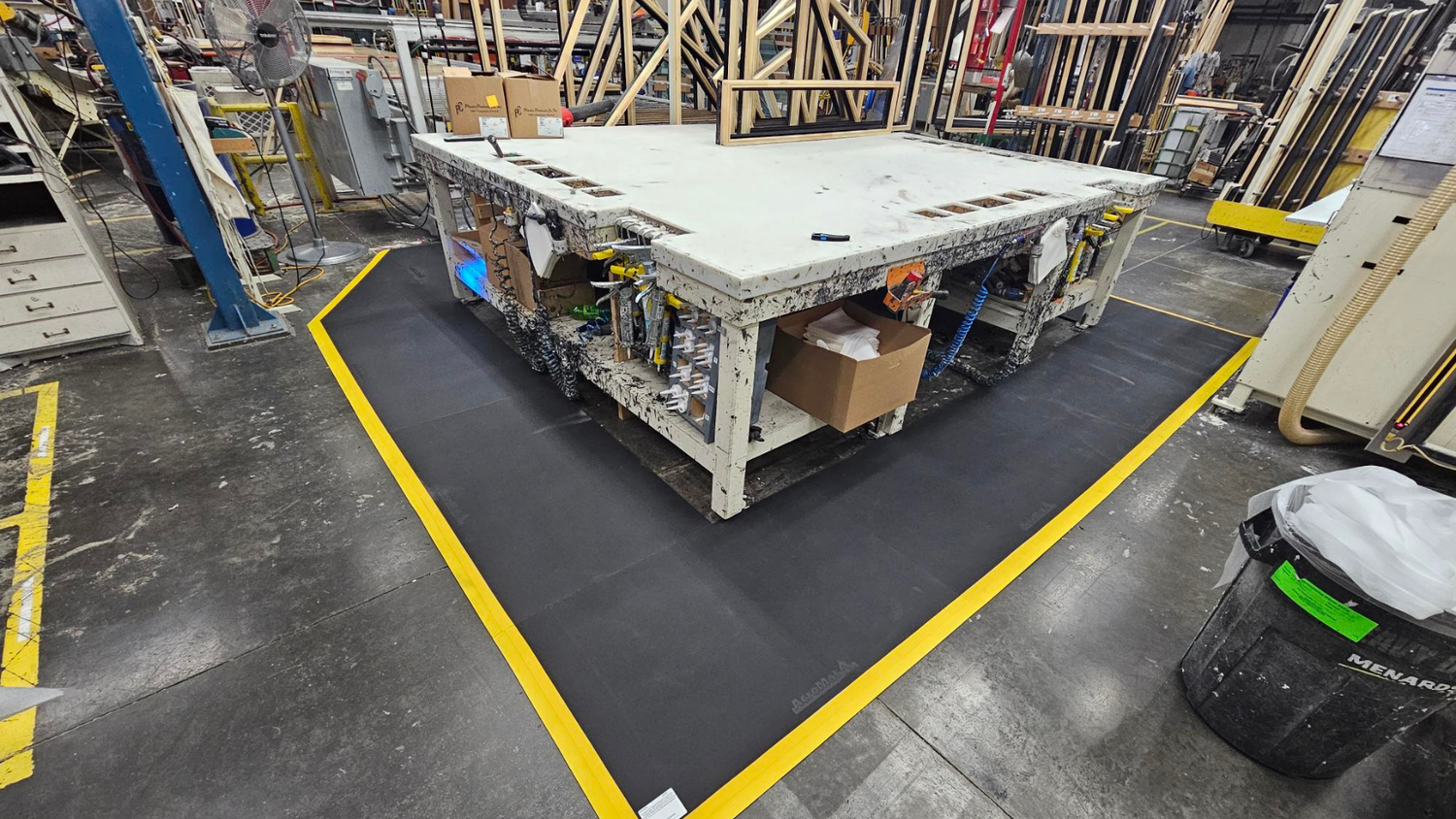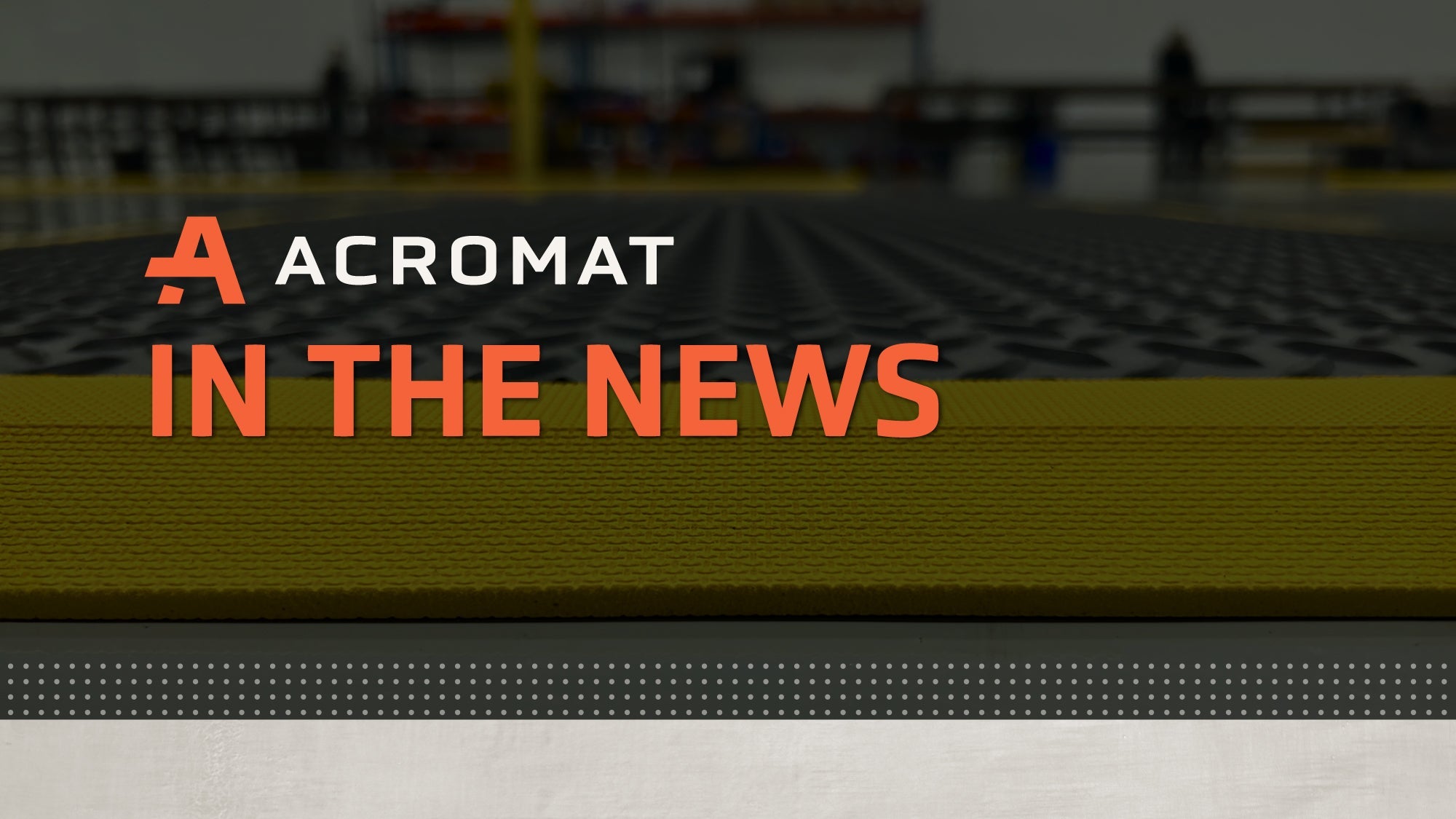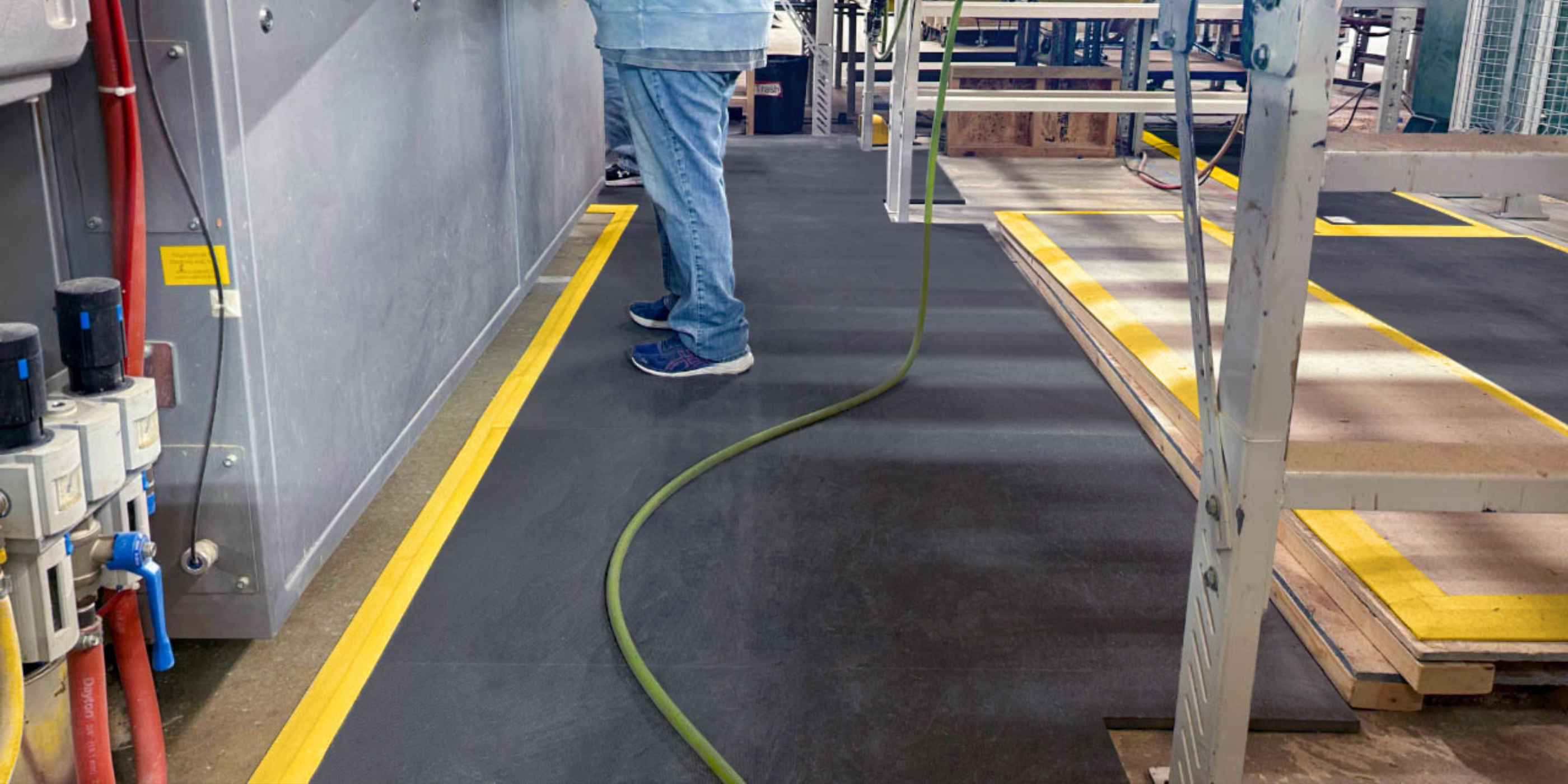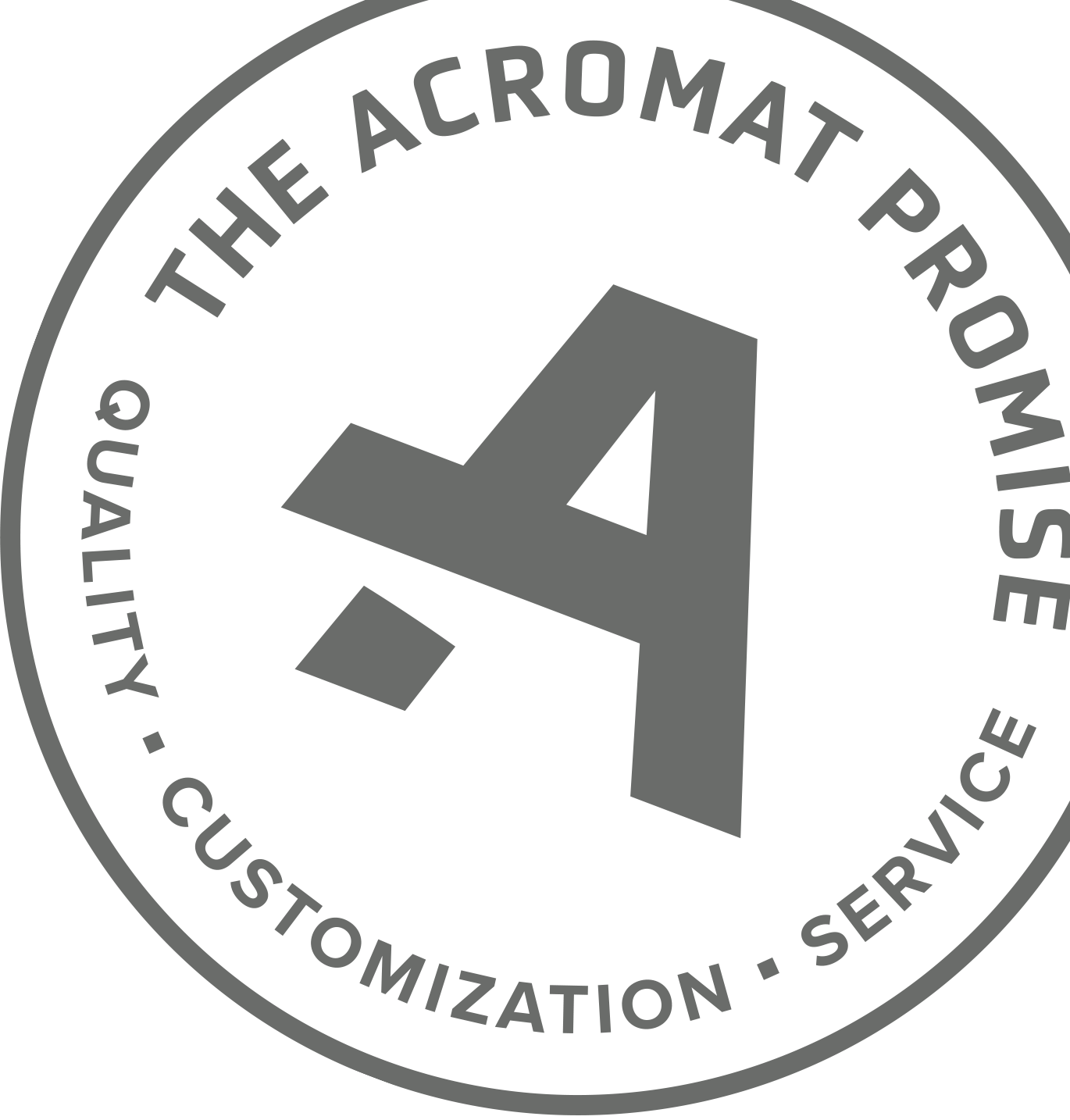Are you considering a change to your anti-fatigue mats in 2025 but unsure where to begin? Are your mats making things worse for your people, but you're not sure why?
Here are 10 signs you need new anti-fatigue mats – including hazards to watch out for and how to eliminate them by getting the right mats.
Take this resource to-go with freely available and printable eBook version, here.
1. Eroded surfaces
Erosion creates an uneven surface, uneven borders, and indicates lost traction. It happens when you have extruded, open cell mats in wet/oily environments. Liquids and chemicals seep into the fabric, causing the mats to bloat, crack and erode across the surface.
Heavy use and constant exposure to liquids have eroded the PVC foam mat below. The erosion has created a slip hazard and clear ergonomic issues due to lost cushion.
This PVC foam mat is an example of the challenges with extruding rubber. Extruding rubber is the easiest and cheapest way to make foam mats, and why so many mat suppliers sell PVC foam mats. However, extruding rubber creates an open cell (porous) construction. As a result, you have a mats that are prone to erosion, cracking, curling, flattening and bloating.
 PVC foam, open cell, extruded anti-fatigue mat. The erosion creates an uneven surface, inconsistent edges, and a clear slip hazard.
PVC foam, open cell, extruded anti-fatigue mat. The erosion creates an uneven surface, inconsistent edges, and a clear slip hazard.
At AcroMat, our mats are made from a virgin, closed cell, 100% nitrile rubber foam that is molded not extruded. Pure nitrile rubber foam is impervious to liquids and chemicals, and as a result endures for ~5 years, on average, in the harshest 24/7 environments.

Left: PVC foam mats curling at the edges and eroding, 2 years into use. Right (AcroMat): 100% nitrile mat fully intact, 2 years into use. Same facility.
2. Mats flipped upside down
28% of safety leaders say they have noticed mats being flipped upside down in their facilities. Mats are flipped over for two reasons. Either the top surface is severely damaged, or the ergonomic support is long gone and your employees think the bottom might provide some comfort – not unlike flipping over a pillow.
The beveled edges on your anti-fatigue mats are designed to create a smooth on/off transition for fast-moving workers. When a mat is flipped over, this transition is disrupted and now you have a dangerous trip hazard.
Finding mats flipped upside down can also signify employees who are unhappy or frustrated with the state of their anti-fatigue mats. When morale drops, production decreases often follow. 
Flipping your anti-fatigue mats upside down creates a trip hazard and ergonomic inconsistencies. Upside down mats may also be a sign of disengaged employees.
3. The wrong shape and size
35% of safety leaders say the No. 1 complaint they receive from employees about their mats is that they're too small or the wrong shape. Mats that are too small force operators to stand half on/off their mats, or worse, constantly shift from mat to concrete.
We asked Certified Professional Ergonomists Mary Plehal and Mike Janak what happens to the human body, ergonomically, when employees are forced to stand on the edge of their mats, or half on/half off, because the mats are too small or the wrong shape.
Mike Janak, ErgoFactor:
"Standing with only half the foot in contact with the mat promotes a non-neutral ankle posture that would be similar to standing on high heels. If the standing postures are static, and the worker stands at the edge of the mat for prolonged periods without moving his/her feet, then the non-neutral ankle posture may result in musculoskeletal (MSD) injury."
Mary Plehal, Optima EHS:
"It changes the biomechanics of the ankle, increases instability and leg/low back fatigue. We are one long kinetic chain, like the old song: 'The foot bone's connected to the ankle bone, the ankle bone's connected to the leg bone, the leg bone's connected to the knee bone...'"

Edge-standing, caused by mats that are too small or the wrong shape for the workspace, increases the risk of tripping, rolled ankles, and MSD injuries.
This 450 sq. ft. custom anti-fatigue mat for a Fortune 500 automotive manufacturer highlights the value of custom mats designed to fit; no on/off stepping or edge-standing, just seamless traction and ergonomic support from end to end.
4. Mats keep sliding around
Over 20% of manufacturing facilities are dealing with anti-fatigue mats that slide around – a dangerous but entirely preventable slip and fall hazard. The average slip and fall injury claim: $50,000 and 12 missed days of works.
If your anti-fatigue mats keep sliding around, it's a clear sign they need to either be replaced or supplemented. Potential solutions include:
I. Create a glove-like fit with AcroSketch.
Anti-fatigue mats custom designed to fit your workspaces create a glove-like fit and have nowhere to slide; they are anchored in place. With AcroMat's proprietary online mat building tool, AcroSketch, you can design mats to any shape and size without limit.
II. Add a non-slip backing or coating
AcroMat makes an eco-bio friendly, non-slip backing called Grip-R. Compliant with all OSHA regulations, the waterproof coating gets painted on to the bottom of a mat and creates a higher coefficient of friction to prevent sliding.
See how Grip-R works in this 2-minute video.
III. Look for 100% nitrile mats over over PVC foam
Anti-fatigue mats made from open cell PVC foam or a PVC/nitrile blends are not impervious to liquids. Instead, they absorb them. This leads to bloating, bubbling and cracking, which peels the mat (and the grip) away from the floor.
Pure nitrile is impervious to liquids and chemicals, helping mats adhere to the floor even in wet/oily and dry/dusty environments. It's also important to keep your workspaces clean, as build-up of particles and dust can create a mini-wheel under your mats.

Before: PVC foam mat out on an island and sliding around, creating a slipping risk.
 After: 100% nitrile custom AcroMat mat. Glove-like fit eliminates threat of sliding. Designed in minutes with AcroSketch for Nokian Tyres' 24/7 manufacturing plant.
After: 100% nitrile custom AcroMat mat. Glove-like fit eliminates threat of sliding. Designed in minutes with AcroSketch for Nokian Tyres' 24/7 manufacturing plant.
Related: Nokian Tyres Eliminates Sliding Anti-Fatigue Mats (Video)
5. Curling borders
Slips, trips, and falls (STFs) are the No. 1 most preventable workplace injury, and curling anti-fatigue mat borders is the one of the most common culprits of STFs in the workplace.
Curling creates an immediate and dangerous trip hazard for fast-moving workers, and forces them to constantly watch their feet rather than focus on the work or the environment around them. It's a clear sign your mats need to be replaced.
The durability of your mats – i.e., how they perform in your particular environment – is the most important factor in preventing curling. How your mats are designed and constructed, followed by clear warranty protections, are critical in terms of putting a permanent end to curling.
 Left: The "waterfall" design. As the porous, PVC foam pad buckles and shrinks from oils and heavy use, this pulls the borders of the mat off the ground. Right: The AcroMat NitriTuf Diamond Series is the only diamond-plate mat guaranteed not to curl.
Left: The "waterfall" design. As the porous, PVC foam pad buckles and shrinks from oils and heavy use, this pulls the borders of the mat off the ground. Right: The AcroMat NitriTuf Diamond Series is the only diamond-plate mat guaranteed not to curl.
Related: 5 Ways to Stop Your Anti-Fatigue Mats From Curling (eBook)
6. Stacked mats
Employees stack anti-fatigue mats for two reasons. Their mats have gone flat and they’re looking for additional comfort, or the mats are hard and uncomfortable – something we often see with tiles. Either way, it's a sign your people aren't happy with their current flooring situation and deeper evaluation is necessary.
According to Ergonomist Mary Plehal:
"The biggest concern from an ergonomic point of view is that stacked mats may seem to have more cushion, but in reality stacking creates postural instability that causes the feet, ankles and upwards to the lower back to have to make constant micro-adjustments to maintain balance. This is similar to working in high heels day after day. It's also common for stacked mats to be different sizes, heights and products, which creates uneven standing surfaces. This is awkward and exposes employees to a higher risk of slips, trips, falls, and rolled ankles."

Stacking creates postural instability similar to working in high heels for hours at a time. AcroMat anti-fatigue mats, with a medium-soft durometer rating, are guaranteed and warrantied never to sink, flatten, or compress.
It's important to test and trial the various anti-fatigue mat options available, and gather feedback from your employees during the trialing process. And stand on the mats yourself. These are two of the best way to gain insight into whether the mats or tiles you're considering are providing the long-term comfort your people need.
According to Darcie Jaremey, Certified Professional Ergonomist and Owner ergonomicsHelp:
"What sets AcroMat mats apart is that they are quite robust to stand on; they hold their shape very well. This means that after standing in one location for a while, the mat doesn’t flatten and doesn’t require you to relocate your feet to get cushion and relief."
7. Flat or sunken mats
Anti-fatigue mats are designed to prevent slip, trip and fall hazards, and prevent ergonomic or MSD injuries. If they sink or compress where you most often stand, they are likely increasing the risk of both. Sinking creates an uneven surface, putting added pressure on your ankles up to your back, and increases the risk of rolled ankles.
Once a mat has begun to compress, there is no returning it to its former level of cushion; the mat will need to be replaced to restore comfort and support to your team members.
5 simple ways to determine if your anti-fatigue mats are compressing:
-Look for footprints in the mat
-Look for air pockets or bubbles in the mat
-Measure the thickness, compare it to when first bought
-Check for stacked mats (often a sign of lost ergo cushion)
-Avoid mats >3/4" thick, 1+" thick often compensates for poor quality

Sinking creates an uneven surface, putting added pressure on your ankles up to your back, and increases the risk of rolled ankles.
Conventional mats, specifically PVC foam, are known for sinking, flattening and losing their ergonomic cushion. At AcroMat, our premium nitrile materials allow us to guarantee our anti-fatigue mats will never fatten or lose their ergonomic cushion from standing. The cushion you begin with will remain unaffected for as long as the mat is in use.
Over 20% of the safety and production leaders we surveyed say the No. 1 complaint they receive from employees about the mats in their facilities is related to "lack of cushion." If you fall into this camp, it's likely your mats are going flat.
8. Piecing mats together
40% of safety and production leaders say "having to piece together rectangular mats" to cover complex workspaces is a major challenge with anti-fatigue mats. Disconnected mats are ‘out on an island,’ making them likely to slide, and the gaps create trip hazards. Designing one-piece, custom mats to fit 'like a glove' is one way to permanently eliminate this issue.

This aerospace manufacturing facility was previously piecing and piling, and stacking, anti-fatigue mats on top of each other. They eliminated the trip hazards and ergonomic inconsistencies with custom AcroMat mats designed to fit.

This window manufacturer replaced runner mats haphazardly pieced together with a 1,500 sq. ft. custom AcroMat mat precisely designed for the workspace.

After an operator tripped over a gap between pieced-together mats, missing over two weeks of work, TruStile Doors replaced this approach with custom AcroMat mats designed to fit. According to the EHS Manager, the entire project cost less than this single injury.
9. Tile seams pulling apart
Modular tiles have to be snapped together like a puzzle, meaning they’re not airtight. They’re also made from a PVC material that isn’t impervious to liquids or chemicals. As products embed in the seams, they begin to pull apart – creating trip hazards.

This manufacturer shifted from "rock hard," tiles that were coming apart at the seams and creating trip hazards, to one-piece custom anti-fatigue mats with AcroMat.
10. Cords and cable hazards
If your anti-fatigue mat workspaces are filled with raised cable covers creating safety issues or slowing down the work of your team members, it may be time for a change.
According to the National Institute of Occupational Safety and Health, one of the easiest ways to reduce STF hazards is to make sure cables don't cross walkways. Unfortunately, with anti-fatigue mats this is usually impossible. The traditional approach is to add a raised cable cover to the area, which creates an additional trip hazard.
One solution is to replace conventional mats with a custom mat that includes a built-in mat channel or flat cable cover. These lay as flat as the mat, eliminate trip hazards, and accommodate cart traffic without issue. Cable covers can be easily added using our custom mat builder, AcroSketch.

This manufacturer designed built-in cable covers directly into their custom AcroMat mats using AcroSketch.
If demands are high and your workers are missing too much work time due to fatigue, injury or pain, look closely at the mats currently in use in your facility. Are they supporting the people who rely on them every day? Are they sending your people home as safe and healthy as when they arrived? Are they helping or hurting your team members?
Take the time to inspect your anti-fatigue mats. Start with the clear and preventable warning signs above. Need a hand? Our team is readily available to provide a site inspection at no cost.





